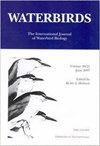尼泊尔低地农田的毛颈鹳(Ciconia episcopus)活动预算:湿地、季节性作物和人类邻近的影响
IF 0.6
4区 生物学
Q3 ORNITHOLOGY
引用次数: 2
摘要
摘要热带农田经历了剧烈的季节变化,景观条件和人类的持续存在,为居住的水鸟提供了潜在的挑战环境。在尼泊尔低地研究了两个季节(季风和冬季,2018-2019)全球受威胁的毛颈鹳(Ciconia episcopus)的行为,以评估鹳如何应对农田不断变化的条件。从582分钟的视频中准备活动预算,并使用递归划分来确定影响两个关键活动的变量:觅食和警惕。觅食是主要活动(32±33%),警戒时间相对较少(10±19%)。毛颈鹳在离湿地较近的地方觅食(25.8±36.3%),比在离湿地较远的地方觅食(35.8±31.8%),觅食时间减少了1%。与季候风(35.1±32.2%)相比,冬季采食时间(30.6±35.2%)减少,表明采食条件有所改善。花在觅食上的时间百分比越来越接近人类,这表明效率更低。在靠近湿地的地方保持警惕的时间百分比减少了,这表明干扰减少了。有人类活动的湿地和旱地是相对高价值的生境。在尼泊尔低地的农田里,长毛颈鹳通过相对较小的方式改变活动预算来应对不断变化的季节条件,这与野生栖息地中类似物种的变化相同。这项工作增加了越来越多的文献,展示了热带农业景观的多功能价值,并强调了摆脱农业对大型水鸟有害的假设的必要性。本文章由计算机程序翻译,如有差异,请以英文原文为准。
Woolly-Necked Stork (Ciconia episcopus) Activity Budget in Lowland Nepal's Farmlands: The Influence of Wetlands, Seasonal Crops, and Human Proximity
Abstract. Tropical farmlands experience dramatic seasonal variations in landscape conditions and have continuous human presence, providing potentially challenging settings for resident waterbirds. Behavior of the globally threatened Woolly-necked Stork (Ciconia episcopus) was studied for two seasons (monsoon and winter, 2018–2019) in lowland Nepal to assess how storks coped with changing conditions on farmlands. Activity budgets were prepared from 582 min of video, and recursive partitioning was used to identify variables that affected two critical activities: foraging and vigilance. Foraging was a dominant activity (32 ± 33%) with relatively little percent time spent being vigilant (10 ± 19%). Woolly-necked Storks reduced percent foraging time when they foraged closer (25.8 ± 36.3%) compared to farther (35.8 ± 31.8%) from wetlands. Percent foraging time was reduced during the winter (30.6 ± 35.2%) compared to monsoon (35.1 ± 32.2%), suggesting improved foraging conditions. Percent time spent foraging increased closer to humans, suggesting lower efficiency. Percent time being vigilant decreased closer to wetlands, suggesting reduced disturbance. Wetlands and drier cropfields with human presence were relatively high-value habitats. Woolly-necked Storks coped with changing seasonal conditions in lowland Nepal's farmlands by altering activity budgets in relatively minor ways identical to alterations made by similar species in wild habitats. This work adds to growing literature showcasing the multifunctional value of tropical agricultural landscapes and underscoring the need to move away from assuming that agriculture is uniformly detrimental for large waterbirds.
求助全文
通过发布文献求助,成功后即可免费获取论文全文。
去求助
来源期刊

Waterbirds
生物-鸟类学
CiteScore
1.30
自引率
0.00%
发文量
0
审稿时长
6-12 weeks
期刊介绍:
Waterbirds is an international scientific journal of the Waterbird Society. The journal is published four times a year (March, June, September and December) and specializes in the biology, abundance, ecology, management and conservation of all waterbird species living in marine, estuarine and freshwater habitats. Waterbirds welcomes submission of scientific articles and notes containing the results of original studies worldwide, unsolicited critical commentary and reviews of appropriate topics.
 求助内容:
求助内容: 应助结果提醒方式:
应助结果提醒方式:


